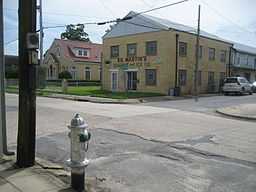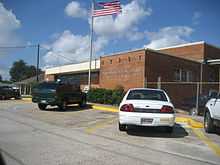Westwego, Louisiana
| City of Westwego | |
| City | |
 | |
| Country | United States |
|---|---|
| State | Louisiana |
| Parish | Jefferson |
| Elevation | 0 ft (0 m) [1] |
| Coordinates | 29°54′11″N 90°08′35″W / 29.90306°N 90.14306°W |
| Area | 3.6 sq mi (9.3 km2) |
| - land | 3.2 sq mi (8 km2) |
| - water | 0.4 sq mi (1 km2), 11.11% |
| Population | 10,763 (2000) |
| Density | 3,378.0 / sq mi (1,304.3 / km2) |
| Mayor | Robert E. Billiot |
| Timezone | CST (UTC-6) |
| - summer (DST) | CDT (UTC-5) |
| ZIP code | 70094 |
| Area code | 504 |
 Location of Westwego in Louisiana
| |
 Location of Louisiana in the United States
| |
| Website: http://www.cityofwestwego.com | |
Westwego is a city in Jefferson Parish, Louisiana, United States, and a suburb of New Orleans. The population was 10,763 at the 2000 census. It lies along the west bank of the Mississippi River.
Geography
Westwego is located at 29°54′11″N 90°8′35″W / 29.90306°N 90.14306°W (29.902986, -90.142932)[2] and has an elevation of 0 feet (0.0 m)[3].
According to the United States Census Bureau, the city has a total area of 3.6 square miles (9.2 km²): 3.2 square miles (8.3 km²) of it is land, and 0.4 square miles (1.0 km²) of it (10.64%) is water.
Name
One story states generally that Westwego was so named because it was a major crossing point on the Mississippi river during the great westward movement of the late 19th century. When travelers were asked their destination, they would often reply "west we go". Another more specific tale, recounted in John Churchill Chase's Frenchmen, Desire, Good Children[4] is that the name was the specific outcome of an 1871 meeting of a railroad board of directors in New York, where planning was undertaken to use the site as an eastern terminus ("...west we go from there"). There has been further speculation that this use of "Westwego" as a place name may have been influenced by the board members' familiarity with the name of Oswego, New York.
History
The area of Westwego, Louisiana was inhabited by Native Americans for thousands of years before Europeans settled here. These indigenous people created huge shells middens that can still be seen in the vicinity today. The French first developed the area in 1719 when French Minister of State LeBlanc started a plantation and a port along the Mississippi River. The port became an important site in the history of the transatlantic slave trade. The estate was later owned by the Zeringue family, who turned it into bustling sugar plantation, known as Seven Oaks. Planter Camille Zeringue built a canal at the plantation that played a prominent role in the community's history for decades. Other antebellum plantations in the area included the Whitehouse Plantation, Magnolia Lane, and the LaBranche Plantation among others. After Camille Zeringue's death, Seven Oaks was owned by Pablo Sala, who divided the property along the canal into lots, which he sold for $40 each. Many of these lots were purchased by displaced hurricane victims from Cheniere Caminada whose homes were destroyed in the great unnamed 1893 storm. With the addition of these families, who were mostly fisherman and trappers, the community of Salaville was born.
Salaville grew and the local railroad barons coined the name "Westwego". A number of industries grew around the city's wetlands and bayous, including those involving fisheries, shrimping, the canning of seafood, etc. Westwego was incorporated as a city in 1951 as its population continued to grow and grow. Within the last decade, Westwego has taken on a number of historical restoration projects, inspired by historian Daniel P. Alario, Sr. In 1977, a grain elevator in Westwego exploded due to a spark igniting grain dust. The explosion killed 36 people. The explosion prompted new safety developments in grain elevators.
Events
Westwego holds a weekly farmers market on Sala Avenue, featuring fresh produce, barbecue, and local bands.
Demographics
As of the census[5] of 2000, there were 10,763 people, 4,211 households, and 2,850 families residing in the city. The population density was 3,378.0 people per square mile (1,302.7/km²). There were 4,521 housing units at an average density of 1,418.9 per square mile (547.2/km²). The racial makeup of the city was 75.16% White, 20.02% African American, 0.94% Native American, 1.57% Asian, 0.91% from other races, and 1.40% from two or more races. Hispanic or Latino of any race were 3.59% of the population.
There were 4,211 households out of which 32.7% had children under the age of 18 living with them, 41.1% were married couples living together, 20.8% had a female householder with no husband present, and 32.3% were non-families. 26.7% of all households were made up of individuals and 10.5% had someone living alone who was 65 years of age or older. The average household size was 2.56 and the average family size was 3.10.
In the city the population was spread out with 27.5% under the age of 18, 8.9% from 18 to 24, 29.9% from 25 to 44, 21.2% from 45 to 64, and 12.5% who were 65 years of age or older. The median age was 35 years. For every 100 females there were 90.5 males. For every 100 females age 18 and over, there were 84.6 males.
The median income for a household in the city was $27,218, and the median income for a family was $31,187. Males had a median income of $29,398 versus $18,916 for females. The per capita income for the city was $13,160. About 17.9% of families and 22.4% of the population were below the poverty line, including 33.7% of those under age 18 and 9.5% of those age 65 or over.
Government and infrastructure

The United States Postal Service operates the Westwego Post Office.[6]
Education
The public schools in Westwego are operated by the Jefferson Parish Public School System.
Elementary schools taking portions of Westwego include Myrtle C. Thibodeaux Elementary School (formerly Westwego Elementary School) in Westwego, Butler Elementary School in Westwego, and Bridge City Elementary School in Bridge City (an unincorporated area).[7] Middle school Westwego residents are zoned to Worley Middle School in Westwego,[8] and high school residents are zoned to Higgins High School in an unincorporated area.[9]
Our Lady of Prompt Succor Catholic School is a private Catholic school in the city.
Jefferson Parish Library operates the Edith S. Lawson Library in Westwego.[10]
Notable natives and residents
- John Alario, dean of the Louisiana State Legislature
- Sidney Arnondin, jazz writer of the song "Lazy River" was a resident of and born in Westwego, March 29, 1901
- Sherman A. Bernard (1925-2012), Louisiana insurance commissioner lived at the time of his election in 1972 in Westwego, where he ran a house moving, trucking, and construction business; later relocated to Marrero.[11]
- Skyler Green, raised in Westwego, professional football wide receiver and return specialist
- Ted Haggard, former Evangelical preacher, lived there for a short while in 2007 after a gay prostitution scandal
References
- ↑ "Westwego, Louisiana". Geographic Names Information System. United States Geological Survey. June 4, 1980. Retrieved 2007-12-12.
- ↑ "US Gazetteer files: 2010, 2000, and 1990". United States Census Bureau. 2011-02-12. Retrieved 2011-04-23.
- ↑ "US Board on Geographic Names". United States Geological Survey. 2007-10-25. Retrieved 2008-01-31.
- ↑ Chase, J C: Frenchmen, Desire, Good Children and Other Streets of New Orleans, page 171. Touchstone, 1979
- ↑ "American FactFinder". United States Census Bureau. Retrieved 2008-01-31.
- ↑ "Post Office Location - WESTWEGO." United States Postal Service. Retrieved on September 26, 2010.
- ↑ "Westbank Elementary." Jefferson Parish Public School System. Retrieved on September 26, 2010.
- ↑ "Westbank Middle." Jefferson Parish Public School System. Retrieved on September 26, 2010.
- ↑ "Westbank High." Jefferson Parish Public School System. Retrieved on September 26, 2010.
- ↑ "Edith S. Lawson Library in Westwego." Jefferson Parish Library. Retrieved on September 28, 2010.
- ↑ "In Memory of Sherman Bernard, Sr.". obits.dignitymemorial.com. Retrieved June 16, 2013.
External links
| Wikimedia Commons has media related to Westwego, Louisiana. |
| |||||||||||||||||
